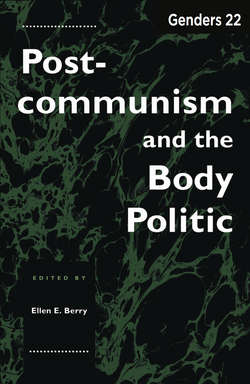Читать книгу Genders 22 - Ellen E. Berry - Страница 24
На сайте Литреса книга снята с продажи.
II
ОглавлениеCultural Categories as Objects of Study. There is an assumption, in the question about women in Yugoslavia, of the difference of Yugoslavian women which precedes any empirical information: it is deduced from the postulated radical difference between the two blocs which, in turn, is a result of the cold war. More specifically, it is assumed: (1) that the two blocs are/were completely ideologically different, and that the acceptance of that difference should be the starting point of any communication; (2) that contacts between the two blocs have been and have to remain external: the blocs can only (or at least primarily) relate to each other as separate entities whose separateness, whose difference, defines/colors every phenomenon within a bloc, as well as every perception of all phenomena from the other bloc; and (3) that, since the two blocs’ histories have been very different, there is no common cultural space they can draw on in their attempts to communicate.
Although, on one level, these assumptions appear to be quite obviously true, on another none of them quite holds. (1) The blocs were not as ideologically different as popularly thought: for one, their propaganda techniques against each other were quite similar;5 then, although there were ideological differences, many of their respective educational canons were similar (great books, great philosophers, great scientific discoveries); finally, they were both part of Euro/Western civilization and subscribed to some of the same cultural and economic goals and ideals: industrialization, urbanization, logocentrism, and so on. (2) The blocs’ boundaries (borders) were not impermeable: popular and other cultural products, people, political and financial interests, and such like, constantly seeped through, ensuring the continued presence of the other bloc on each of their soils (for example, rock music and popular movies went East, ballet and Russian literary classics traveled West). (3) This constant seepage, together with other globalizing trends,6 has worked toward creating (or, rather, maintaining?) a common cultural space which frequently (under the cold-war paradigm) went unrecognized.
In other words, an assumption of across-the-board difference between Eastern and Western blocs may not be accurate; furthermore, this assumed difference may not always be descriptive but rather prescriptive: it postulates a difference between the blocs, and this postulate is then imposed on the actual diversity which exists inside the blocs in such a way that only certain characteristics — those which are different — are considered authentic and scholarly acceptable while others are ignored as unclear, or rather, impure. In short, this process as much produces new differences between blocs as it reflects differences which already do exist. It follows that not only is the identity which I am invited to represent a culturally constructed category (and so is the very position of difference from which I am encouraged to speak), but the label “Yugoslavian women” also implies far more difference from all other, non-Yugoslavian, women and far more internal homogeneity among Yugoslavian women than exists in reality. (Among other things, this might not be good for the project which it seeks to support — namely, openness to cultural difference and a “better,” safer, more peaceful world — since it is, in fact, yet another kind of homogenization.)
Cornel West points out that “notions of the ‘real Black community’ and ‘positive’ image are value-laden, socially loaded, and ideologically charged.”7 So is the category of women in Yugoslavia. And so are the concepts of the two blocs, American and Soviet, as good and bad, as free and behind the iron curtain. Recognizing this might be comparable to what Stuart Hall calls “the end of [Black] innocence”; the “recognition that ‘Black’ is essentially a politically and culturally constructed category.”8 Facing the cultural constructedness of categories such as Yugoslavian women and Eastern Bloc, means not only the end of “innocence” which characterized the cold-war paradigm and the desire for cross-bloc communication, but also a realization that the opening up of the “fircond” world, theoretically at least, calls for a redefinition of both blocs’ discourses; that both labels — “the free world” and the “world behind the iron curtain” — need to be rethought. Only then will all the diverse voices (such as those of different national cultures, various ethnic groups, women, different classes, etc.) during the cold war subsumed under homogenizing bloc labels, fully emerge.
